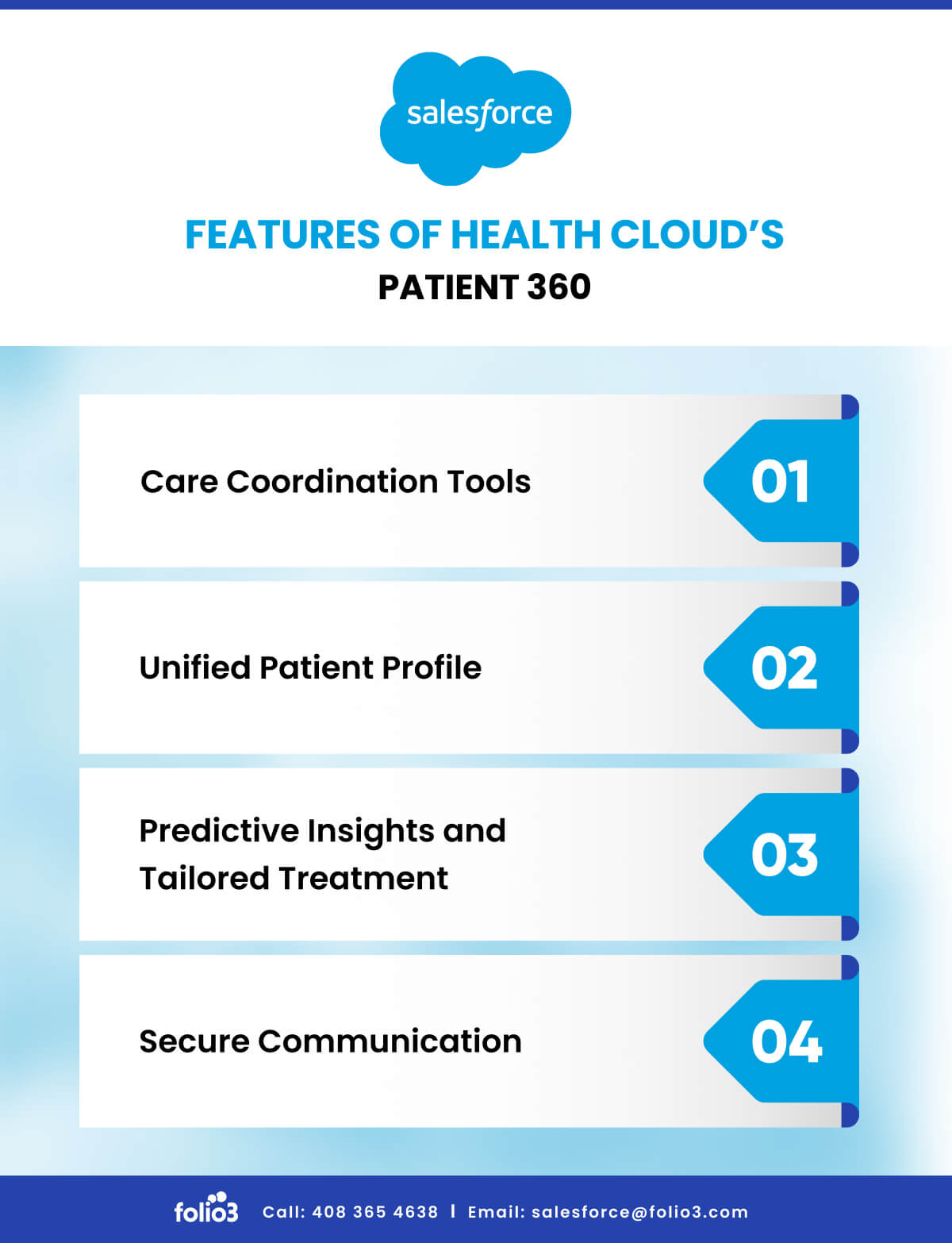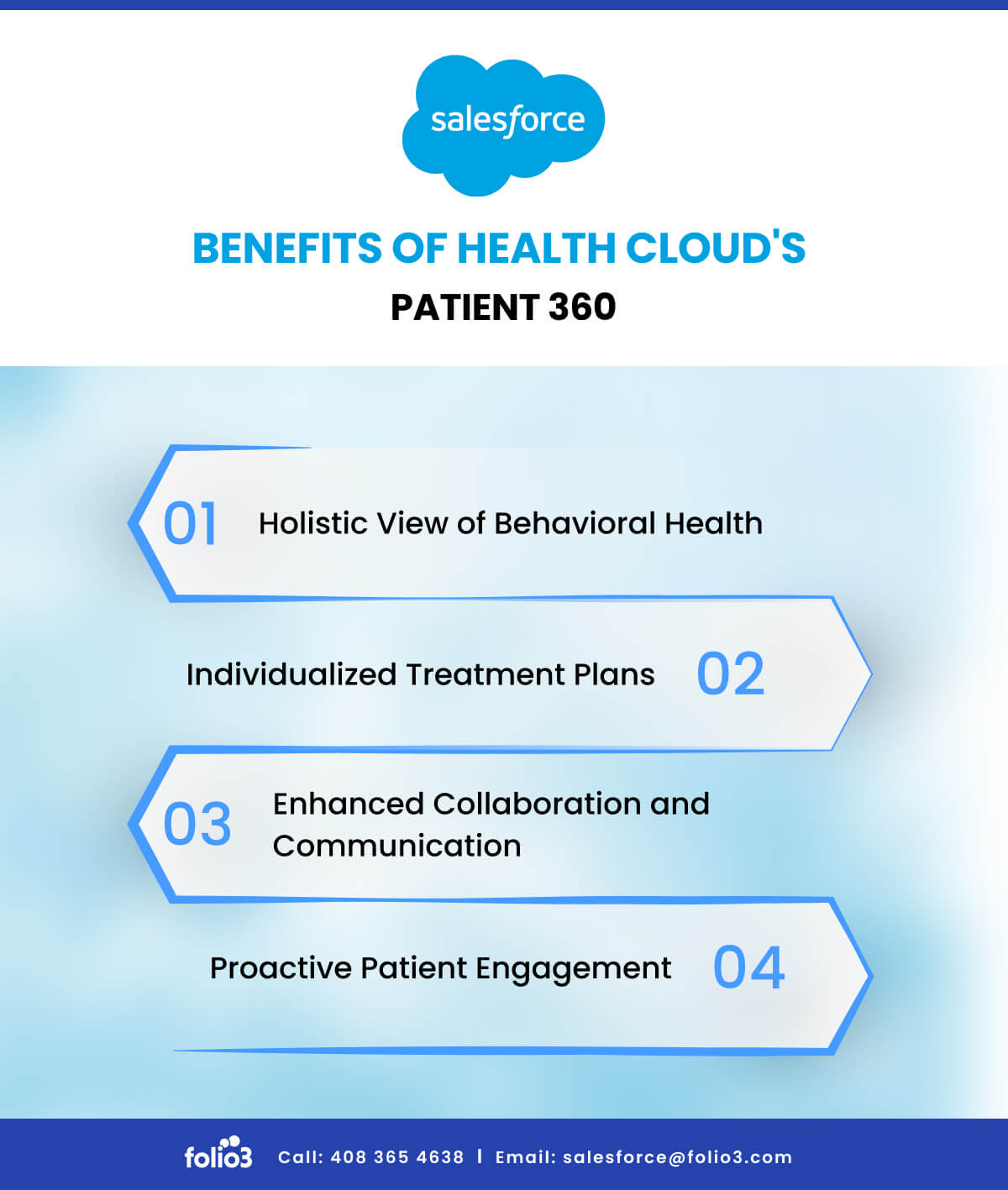Patients are now expecting more personalized and coordinated care from their healthcare providers. However, delivering this kind of care can be challenging for healthcare organizations.
But there is a way to address the challenges effectively, and for that, Salesforce has developed Patient 360—it’s a powerful tool within its Health Cloud platform.
l designed to provide a comprehensive and unified view of patient data, enabling healthcare organizations to deliver personalized and coordinated care to their patients.
Let’s have a quick overview of Salesforce Patient 360 and how it helps healthcare organizations.
What Is Salesforce Patient 360 of the Health Cloud?
It is a key component of Salesforce Health Cloud that aims to promote personalized patient Interaction. It gathers data from various sources to gain profound insights.
This feature elevates the quality of patient care and enhances outcomes. Healthcare professionals use it to easily access critical information and steer more informed decisions.
Salesforce Health Cloud implementation enables healthcare organizations to gain a 360-degree view of their patients. It provides the full picture of each patient’s electronic health records, including medical history, lab results, and medications.
How Salesforce Patient 360 Works?
There are actually two things to consider when asking about Salesforce Patient 360:
1. Salesforce Patient 360 Platform
This is a broader offering from Salesforce aimed at the healthcare industry. It connects various data sources and systems across an organization, providing a unified view of patients and their health journey.
Think of it as a foundation for building various patient-centric solutions leveraging advanced Salesforce integration services to connect disparate healthcare systems seamlessly. Here’s how it works:
|
Integrates data from various sources like EHRs, claims data, patient portals, wearables, etc. |
|
Leverages AI (Einstein) to analyze data, generate insights, predict risks, and personalize care. |
|
Offers real-time updates on patient status, allowing for more informed decision-making. |
|
Automates manual tasks like appointment reminders, referrals, and billing processes. |
|
Offers tools for patient engagement and communication. |
2. Patient 360 App (also known as Patient 360 View)
This is a specific app available on the Salesforce AppExchange. It leverages the platform to offer a 360-degree view of an individual patient’s medical profile.
It pulls together information from disparate sources like electronic health records, appointment scheduling, and billing systems, presenting it in a single, easy-to-understand format. Here’s how it works:
|
Displays all relevant patient information in one place, including demographics, medical history, medications, allergies, upcoming appointments, etc. |
|
Presents data in charts and graphs for easier understanding. |
|
Allows healthcare providers to tailor the view to their specific needs. |
|
Facilitates communication and collaboration between healthcare teams involved in patient care. |
Features of Health Cloud’s Patient 360
Explore how these four excellent features of Salesforce Health Cloud make a huge difference in healthcare.
Care Coordination Tools
The care coordination tool in Patient 360 Salesforce streamlines the treatment process. These tools facilitate task assignments and follow-ups to keep team members informed and involved.
Its real-time updates also support providers to identify and address any potential issues. This efficient system promotes collaborative care and enhances patient satisfaction.
Unified Patient Profile
Data from diverse sources such as medical records, diagnostic tests, and wearable devices constructs a unified and detailed patient profile under a Patient 360 cloud overview.
Professional Salesforce implementation services ensure this integration provides seamless access to essential health information while enhancing the overall efficiency of healthcare professionals.
Predictive Insights and Tailored Treatment
Advanced analytics and AI are central to Salesforce Patient 360 capabilities. These features enable predictive insights, helping providers anticipate patient needs.
Moreover, AI-driven tools analyze behavioral patterns to tailor treatment approaches. The platform supports proactive care delivery that can lead to better patient outcomes.
Secure Communication
The platform is also essential for secure communication. After all, facilitating privacy and confidentiality for patients is what they are known for.
The platform allows encrypted messaging between patients and care teams. This secure pathway from Salesforce 360 is vital in behavioral health, where sensitive information often differs.
To explore more about how Health Cloud transforms healthcare delivery, read about Salesforce Health Cloud automating healthcare through rapid data and AI advancement.
Benefits of Health Cloud’s Patient 360
Incorporating Salesforce Health Cloud’s Patient 360 tool into a healthcare practice equips teams with the resources to optimize patient care in behavioral health settings. Following are the benefits of Health Cloud Patient 360:
Holistic View of Behavioral Health
Salesforce Health Cloud’s innovative Patient 360 tool revolutionizes caregiving by offering a complete view of a patient’s behavioral health journey. This latest tool consolidates medical histories and treatment responses with essential social determinants of health.
By presenting all this crucial information in one comprehensive view, providers acquire deep insights into every aspect influencing a patient’s well-being.
That is how detailed understanding helps caregivers identify patterns and personalize treatments to deliver more effective care.
Individualized Treatment Plans
Various resources, including medical records, diagnostic tests, and patient history, turn highly advantageous when integrated under Salesforce Patient 360.
It renders a strong foundation for creating highly individualized treatment plans. They are specifically made to address distinct circumstances and requirements.
Moreover, healthcare providers can adjust treatment strategies in response to the patient’s evolving progress or changing health status. This dynamic adaptation leads to a higher rate of success in treatment effectiveness.
Enhanced Collaboration and Communication
A centralized platform is a vital hub for improved communication within the healthcare team. As a collaborative space, Salesforce Health Cloud’s Patient 360 technology allows specialists, general practitioners, and allied health professionals to access and share up-to-date patient information.
This comprehensive approach keeps each decision well-informed through the latest data trends. Thereby bridging any potential gaps that might appear in care.
It also significantly reduces the likelihood of errors or oversights in the inpatient treatment journey. Healthcare organizations can further enhance coordination between stakeholders by implementing payer provider portals.
Proactive Patient Engagement
It engages patients proactively and comprehensively in their care journey. Calling it a powerful tool at their disposal would not be wrong.
Its customizable engagement plans are tailored not only to individual patient needs but also to automated communications. This quality keeps patients well-informed and actively involved in their treatment.
In the end, it plays a pivotal role in nurturing a strong and trusting relationship between patients and caregivers, especially in behavioral health management.
Challenges of Salesforce Patient 360 [+ Solutions]
Thinking that this platform is a completely smooth process is not a smart move. Remember, every invention has certain drawbacks, too. But you can manage the loss with the right approach.
Lack of Compatibility
Integrating multiple healthcare data systems poses a prominent challenge. For example, different software and platforms often operate in silos, making it hard to synchronize data.
At this point, adopt standards that ensure compatibility across systems. Organizations can also hire Salesforce developer teams with healthcare expertise to bring cohesion to disparate information systems.
Data Inaccuracy
Maintaining the accuracy of healthcare data is another hurdle. Simply put, inaccurate data causes misinformed decisions, which is dangerous to patient care. However, there is solution to it.
You can resolve this by establishing rigorous data entry protocols and continuous training for staff. Also, regular audits and updates to the system maintain high data quality and reliability.
Partnering with experienced Salesforce consulting partner helps organizations establish robust data governance frameworks and maintain compliance with healthcare data standards.
Provider and Patient Engagement
Engaging providers and patients is key to a successful healthcare system. The possible difficulty at this point is that health providers may resist new technologies due to the learning curve.
At the same time, patients might be wary of sharing personal information. Clear communication, coupled with user-friendly technology, is the solution to it.
Navigating Evolving Healthcare Regulations
Navigating the complex landscape of healthcare regulations demands constant vigilance. Changes in laws can quickly make systems non-compliant.
That is why continuous education on regulatory updates and integrating compliance into healthcare IT infrastructure is essential.
Organizations transitioning from legacy systems should leverage Salesforce migration services to ensure data integrity and compliance throughout the migration process. This proactive approach minimizes the risk of penalties and ensures ongoing adherence to regulations.
Is Salesforce Patient 360 the Right Choice for You?
To understand if Patient 360 is actually the right investment for your healthcare business, you need to ask the following questions.
1. Can You Have Privacy and Security with Patient 360?
When selecting a system or platform, prioritize privacy and security. The cloud should protect sensitive data with powerful encryption and access controls.
In addition to this, you can also train your staff in best cybersecurity practices to mitigate risks. Remember, understanding regulatory compliance prevents legal issues and earns customer trust.
2. Is It Scalable and Customizable?
Salesforce development services allow you to customize and scale your software as your business grows. It is a crucial consideration when building an IT infrastructure.
Your technology should upgrade and adapt with you rather than forcing you to invest in new systems every few years. Therefore, it’s not scalable and customizable, so it may not be the right choice for your business.
3. Is It User Friendly?
Another key factor to consider is to ensure the new system is user-friendly. The reason is to facilitate a smooth transition.
Businesses must also implement Salesforce managed services to provide ongoing support that helps users adapt to updates and changes. Also, encouraging open feedback from users can lead to improvements and higher customer satisfaction.
Conclusion
Salesforce Patient 360 falls under the umbrella of Health Cloud. This cloud offers a comprehensive package that addresses all the necessary factors for improved patient care:
- Personalized Care: Provides a holistic view of patients.
- Centralized Platform: Improves communication and collaboration among healthcare teams.
- Secure Communication: Enables encrypted messaging between patients and providers.
Challenges to Consider
While Salesforce CRM Healthcare use offers significant benefits, there are challenges to address:
- Data integration, accuracy, user adoption, and navigating regulations all require solutions.
Making the Right Choice
Before implementing Salesforce CRM Healthcare use, consider these factors:
- Security
- Scalability
- User-friendliness
- Support
By adopting the technological power of Salesforce CRM for healthcare, healthcare professionals and organizations can achieve better gains and deliver exceptional patient care.
Working with a certified Salesforce Health Cloud consultant ensures your organization maximizes the platform’s potential and achieves measurable improvements in patient outcomes and operational efficiency.
FAQs
How Is Salesforce Used in Healthcare?
Salesforce is used in healthcare for various purposes, including patient management, appointment scheduling, care coordination, and data analytics.
Can Salesforce Be Used as an EHR?
While Salesforce is not a traditional electronic health record (EHR) system, it can be customized and integrated to function as a platform for managing health-related data.
How Many Healthcare Companies Use Salesforce?
The exact number of healthcare companies using Salesforce Patient 360 may vary. Still, many healthcare organizations globally leverage Salesforce for customer relationship management (CRM) needs and enhance various aspects of healthcare operations.

Hasan Mustafa
Engineering Manager Salesforce at Folio3
Hasan Mustafa delivers tailored Salesforce solutions to meet clients' specific requirements, overseeing the implementation of scenarios aligned with their needs. He leads a team of Salesforce Administrators and Developers, manages pre-sales activities, and spearheads an internal academy focused on educating and mentoring newcomers in understanding the Salesforce ecosystem and guiding them on their professional journey.


![Challenges of Salesforce Patient 360 [+ Solutions]](https://crm.folio3.com/blog/wp-content/uploads/2024/02/Challenges_of_Salesforce__Patient_360-1.jpg)